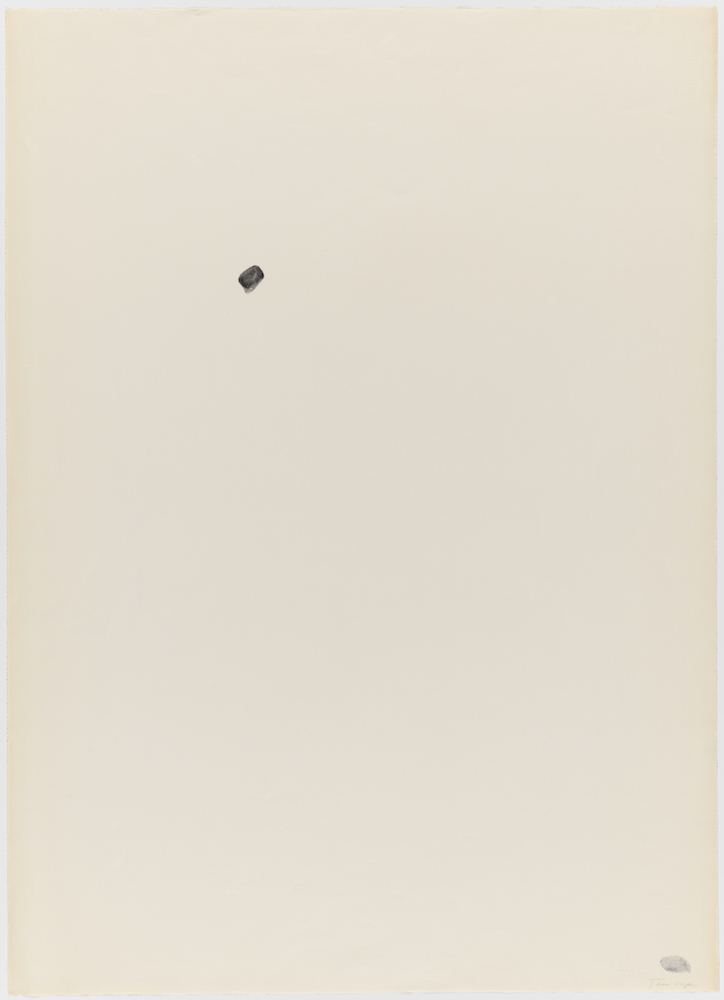
Bruce Conner, THUMB PRINT, April 26, 1965; lithograph, 41 ¾ x 30 in. (105.1 x 76.2 cm); Accessions Committee Fund purchase, 2015; © Conner Family Trust, San Francisco / Artists Rights Society (ARS), New York
Bruce Conner’s lithograph THUMB PRINT (April 26, 1965) is empty except for two thumbprints—one positioned toward the upper left, within the area conventionally occupied by the content of an artwork; and one in the bottom right corner, in place of a signature. Artistically, Conner evacuates his piece, purging it of any recognizable workmanship. Forensically, however, he forcefully occupies the work, using his thumbprint to declare it as his exclusive domain. A notorious provocateur, Conner took pleasure in making art that confounds through contradiction. In THUMB PRINT he enacts a paradox of authorship, withdrawing from the work at the same time as he lays claim to it.
By 1965, the year he made THUMB PRINT, Conner had gained unwanted renown as an artist. The success of his earlier assemblages made by wrapping accumulations of found objects in nylon stockings had led to a cascade of exhibitions throughout the early 1960s. This acclaim worried Conner, who remained suspicious of the art world’s fascination with celebrity. Wealthy collectors who pursued his work seemed to be “autograph collecting,” according to Conner.1 Writing to his close friend Michael McClure in 1965, he conveyed a “feeling of death from the ‘recognition’ I have been receiving.”2
Conner concocted various strategies to undermine this cult of personality. He began to sign his pieces “Anonymous,” “Anon,” and “Unsigned”—or did not sign them at all. He presented his work under various pseudonyms: Emily Feather, Anonymouse, and Justin Kase, among others. THUMB PRINT’s prankish blankness is consistent with these attempts at concealment. The extravagant detail of his drawings and assemblages is absent. There is little to indicate his authorship other than these fingerprints, which lithographers conventionally deem printer’s errors. Conner committed this mistake on purpose, reducing his work to what many considered an artless blemish.
Fingerprints, however, are unique marks of attribution, and Conner knew that the ridges, deltas, and pores of his thumb formed a singular whorl attributable only to him. “I considered it to be a more authentic documentation of the artist,” he argued.3 Years later, when an employer asked him to submit prints for their records, Conner would initially refuse, claiming that they were private property. In this light, THUMB PRINT becomes a personal—even private—impression of the artist, emphatically returning the work to Conner.
In 1964 Conner produced and distributed two lapel pins, one reading “I AM BRUCE CONNER” and the other, “I AM NOT BRUCE CONNER.” THUMB PRINT extends this game of self-inversion, hovering between presence and absence. This liminality reveals a different kind of authorship—one that emerges less from the artist’s creative drive than from the fact of his physical presence: what makes THUMB PRINT a work of art is simply the fact that an artist touched it. Indeed, as Conner impressed his thumb on the lithographic stone, his sweat formed part of the printing gum and transferred to the paper with each impression. In this way, every print includes the tiniest remnant of Conner himself. THUMB PRINT becomes the somatic trace of the artist—not so much a piece by Conner, but a piece of him.
Notes
- Jack Rasmussen, interview with Bruce Conner, in Rasmussen, ed., After Bruce Conner (Washington, DC: American University Museum, 2005), 7.
- Letter from Bruce Conner to Michael McClure, October 22, 1965, Bruce Conner Papers, The Bancroft Library, University of California, Berkeley; quoted in Laura Hoptman, “Beyond Compare: Bruce Conner’s Assemblage Moment, 1958–64,” in Rudolf Frieling and Gary Garrels, eds., Bruce Conner: It’s All True (San Francisco: San Francisco Museum of Modern Art in association with University of California Press, 2016), 282.
- Mary Fuller, “You’re Looking for Bruce Conner, the Artist, or What Is This Crap You’re Trying to Put Over Here?” Currant 2, no. 1 (May–July 1976): 10.